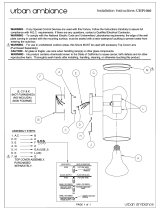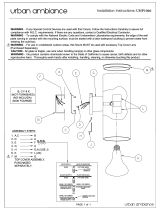Page is loading ...

ITEM #0752251
0756713
MODEL #CLL239-2BNK
CLL239-2BZ
1
ATTACH YOUR RECEIPT HERE
Serial Number
Purchase Date
Questions, problems, missing parts? Before returning to your retailer, call our customer
service department at 1-866-389-8827, 8 a.m. - 6 p.m., EST, Monday - Thursday, 8 a.m. -
5 p.m., EST, Friday.
AB15650
Lowes.com
LED FLUSHMOUNT
CEILING FIXTURES
(SET OF 2)
Français p. 10
Español p. 19
Project Source® is a registered trademark
of LF, LLC. All Rights Reserved.
E465631

BB
Machine
Screw
Qty. 4
HARDWARE CONTENTS (shown actual size)
PACKAGE CONTENTS
2
A Fixture
B Glass Shade
PART DESCRIPTION QUANTITY
A
B
D
E
F
Mounting Strap
C
Fixture Screw 4
(preassembled to Mounting Strap (C))
Threaded Rod
Lowes.com
F
Nut
2
E
2
D
C
2
2
2
Wire
Connector
Qty. 6
AA
(preassembled to Threaded Rod (E))
CC
Finial
Qty. 2
READ AND SAVE THESE INSTRUCTIONS.
DANGER
• For your protection and safety, carefully read and understand the information provided in this
manual completely before attempting to assemble, install or operate this product. Failure to do so
could lead to electrical shock, fire or other injuries that could be hazardous or even fatal.
• DO NOT connect this fixture to an electrical system that does not provide a means for equipment
grounding. Never use a fixture in a two-wire system that is not grounded. Installing a fixture into an
electrical system not having a proper grounding means could cause metal parts of the fixture to
carry electrical currents if any of the fixture wires, wire connections or splices were to become
broken, cut or loose during the mounting or normal operation of the fixture. Under this condition,
anyone coming in contact with the fixture would be subject to electrical shock, which could cause
serious injury or death.
SAFETY INFORMATION
DD
Rubber
Washer
Qty. 2

3
Lowes.com
READ AND SAVE THESE INSTRUCTIONS.
SAFETY INFORMATION
G
• DO NOT connect the bare or green insulation fixture ground wire to the black (HOT) current-carrying
wire or the white neutral house wire. Connection of the bare or green fixture ground wire to the black
or white house wires may cause metal parts of the fixture to carry electrical currents. Under this
condition anyone coming in contact with the fixture will receive electrical shock, which could cause
serious injury or death.
• DO NOT damage or cut the wire insulation (covering) during installation of fixture. DO NOT permit
wires to contact any surface having a sharp edge. To do so may damage or cut the wire insulation,
which could cause serious injury or death from electrical shock.
DANGER
WARNING
• All electrical connections must be in agreement with local codes and ordinances, the National
Electric Code (NEC) and ANSI/NFPA 70-1999. Contact your municipal building department to learn
about your local codes, permits and/or inspections. Risk of fire - most dwellings built before 1985
have supply wire rated for 140°F (60 °C). Consult a qualified electrician before installation.
• To avoid personal injury, the use of gloves may be necessary while handling fixture parts with sharp
edges.
• DO NOT suspend any fixture by the house wires. A fixture must always be mounted directly to an
outlet box or to a mounting strap that is first attached to the outlet box. Wire connectors will not
support the weight of a fixture. Suspending a fixture by the house wires and wire connectors will
result in the fixture falling, with the possibility of personal injury and the danger of electrical shock or
fire.
• To reduce the risk of fire, electrical shock or personal injury, wire connectors provided with this light
fixture are designed to accept only one 12-gauge house wire and two lead wires from the light
fixture. If your house wire is larger than 12-gauge or there is more than one house wire to connect to
the corresponding fixture lead wires, consult an electrician for the proper size wire connectors to
use.
• NOTE: This equipment has been tested and found to comply with the limits for a Class B digital
device, pursuant to Part 15 of the FCC Rules. These limits are designed to provide reasonable
protection against harmful interference in a residential installation. This equipment generates,
uses and can radiate radio frequency energy and, if not installed and used in accordance with
the instructions, may cause harmful interference to radio communications. However, there is no
guarantee that interference will not occur in a particular installation. If this equipment does cause
harmful interference to radio or television reception, which can be determined by turning the
equipment off and on, the user is encouraged to try to correct the interference by one or more of
the following measures:
* Reorient or relocate the receiving antenna.
* Increase the separation between the equipment and receiver.
* Connect the equipment into an outlet on a circuit different from that to which the
receiver is connected.
Consult the dealer or an experienced radio/TV technician for help.

PREPARATION
ASSEMBLY INSTRUCTIONS
ON
OFF
ON
OFF
Turn off circuit breakers and wall switch to
the fixture supply line leads.
DANGER: Failure to disconnect power
supply prior to installation may result in
serious injury or death.
1
1.
4
Before beginning assembly of product, make sure all parts are present. Compare parts with
package contents list and hardware contents list. If any part is missing or damaged, do not attempt
to assemble the product.
Estimated Assembly Time: 30 minutes (per fixture)
Tools Required for Assembly (not included): Flathead Screwdriver, Phillips Screwdriver, Wire
Strippers, Pliers, Wire Cutters, Safety Glasses, Stepladder, Electrical Tape
Helpful Tools (not included): A/C Tester Light, Do-It-Yourself Guide, Soft Cloth
• TURN OFF ELECTRICITY at main fuse box (or circuit breaker box) before beginning installation by
removing the fuse (or switching the circuit breaker off).
• If you are not sure the lighting system has a grounding means, DO NOT attempt to install this fixture.
Contact a qualified, licensed electrician for information regarding the proper grounding methods as
required by the local electrical code in your area.
• All fixtures must be mounted to an outlet box that is supported by the building structure.
• If a dimmer control switch is used with this fixture, obtain professional advice to determine the
correct type to use as well as the electrical rating required.
• Do NOT tamper with or attempt to repair LED component of fixture. The light source is designed for
this specific application and should not be serviced by untrained personnel. If any servicing is
required, call our customer service department.
CAUTION
Lowes.com
SAFETY INFORMATION
NOTE: Dimmable to 10% with select dimmers. See Lowes.com for more information.

ASSEMBLY INSTRUCTIONS
5
Outlet Box
Remove existing fixtures and disconnect all
electrical wiring.
2.
2
Lowes.com
3.
Hardware Used
Machine Screw
x 2
BB
Attach mounting strap (C) to outlet box
(not included) using existing washers and
outlet box screws or the machine screws
(BB). NOTE: If the outlet box screws required
for your outlet box are of a different size than
the machine screws (BB), consult a licensed
electrician before proceeding.
Tighten machine screws (BB) to secure
mounting strap (C) to outlet box.
CAUTION: Make sure the outlet box can
support 35 lbs. hanging weight. Use metal
outlet box; plastic outlet boxes are not
recommended.
3
Washer
BB BB
Outlet Box
C

6
ASSEMBLY INSTRUCTIONS
Prepare wire by stripping 3/4 in. of insulation from
wire ends using wire strippers (not included).
Connect WHITE wire from fixture (A) to WHITE wire
from outlet box using existing wire connector or wire
connector (AA).
Connect BLUE (or BLACK) wire from fixture (A) to
BLACK wire from outlet box using existing wire
connector or wire connector (AA).
Connect BARE/GREEN ground wire from outlet box
to BARE ground wire from fixture (A) using existing
wire connector or wire connector (AA).
NOTE: Screw wire connectors (AA) on in a
clockwise direction.
WARNING: Never connect BARE/GREEN
ground wire to WHITE or BLACK power supply
wires.
WARNING: To reduce the risk of fire, electrical
shock or personal injury, wire connectors (AA) are
designed to accept only one 12-gauge house wire
and two lead wires from the light fixture. If your
house wire is larger than 12-gauge or there is more
than one house wire to connect to the
corresponding fixture lead wires, consult an
electrician for the proper size wire connectors to
use.
4.
x 3
Hardware Used
Wire Connector
AA
Lowes.com
4
Outlet Box
BARE/
GREEN
WHITE
BLACK
BARE
AA
AA
C
A
WHITE

ASSEMBLY INSTRUCTIONS
7
Wrap electrical tape (not included) around each
individual wire connector (AA) down to the wire.
WARNING: Make sure no bare wire or wire
strands are visible after making connections.
Carefully arrange excess wiring and wire
connectors (AA) within outlet box.
5.
6.
Align keyslot holes on fixture (A) with fixture
screws (D) on mounting strap (C) and push
up. Turn fixture (A) clockwise until it no
longer turns. Secure fixture (A) to mounting
strap (C) by tightening the fixture screws
(D).
7.
Remove nut (F) from threaded rod (E).
Save the nut (F) for later use. Then, attach
threaded rod (E) to fixture (A), ensuring it
is completely secure.
Lowes.com
5
Outlet Box
AA
AA
6
Outlet Box
7
D
D
A
C
A
A
F
E

8
ASSEMBLY INSTRUCTIONS
CARE AND MAINTENANCE
9.
Restore power and test fixtures (A).
If fixtures (A) do not function, please refer
to the TROUBLESHOOTING guide on the
next page.
A
9
Lowes.com
8.
Align hole in glass shade (B) with threaded
rod (E) and push up gently on glass shade
(B) until threaded rod (E) comes through
hole in glass shade (B). Secure glass
shade (B) with rubber washer (DD) and nut
(F) previously removed (Step 7, Page 7),
then finial (CC).
CAUTION: Do not overtighten nut (F) or
finial (CC) as glass may crack or break.
Repeat Steps 3 - 8 to install second fixture.
8
A
• Shut off main power supply. Wipe fixture with soft, damp cloth. Use window cleaner to clean glass.
Do not use an abrasive cleaner on glass or fixture.
• Total wattage for each fixture is 17 watts; do not attempt to replace the LEDs.
Hardware Used
Finial
x 1
CC
A
CC
F
B
E
DD
DD
Rubber Washer
x 1

9
Printed In China
Project Source
®
is a registered trademark of
LF, LLC. All rights reserved.
JMLI1507
Lowes.com
TROUBLESHOOTING
Fuse blows out or
circuit breaker trips.
1. Power is OFF.
2. Faulty connection.
3. LED component is not
working properly.
1. Crossed wires.
2. Power wire is grounding out.
1. Check wiring.
2. Check all connections.
1. Make sure power supply is ON.
2. Check wiring and all connections.
3. Contact customer service.
PROBLEM POSSIBLE CAUSE CORRECTIVE ACTION
WARNING: Before beginning work, shut off the power supply to avoid electrical shock.
Light does not come
on initially or no longer
comes on.
WARRANTY
The distributor warrants all of its lighting fixtures against defects in materials and workmanship for
five (5) years from the date of purchase. If within this period the product is found to be defective, take
a copy of the bill of sale as a proof of purchase and the product in its original carton to the place of
purchase. The distributor will, at its option, repair, replace or refund the purchase price to the
consumer. All costs of installation and removal of the fixture is the responsibility of the consumer. This
warranty does not cover fixtures becoming defective due to misuse, accidental damage or improper
handling and/or installation and specifically excludes liability for direct, incidental or consequential
damages, improper packaging of returned products and acts of God. As some states do not allow
exclusions of limitations on an implied warranty, the above exclusion and limitation may not apply.
This warranty gives you specific rights and you may also have other rights which may vary from state
to state.
/




